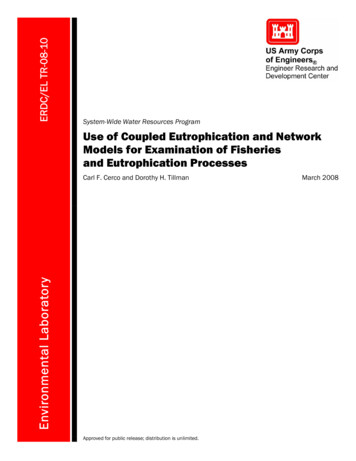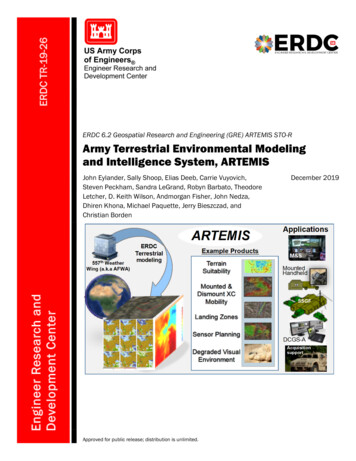
Transcription
ERDC/EL TR-08-10System-Wide Water Resources ProgramUse of Coupled Eutrophication and NetworkModels for Examination of Fisheriesand Eutrophication ProcessesEnvironmental LaboratoryCarl F. Cerco and Dorothy H. TillmanApproved for public release; distribution is unlimited.March 2008
System-Wide Water Resources ProgramERDC/EL TR-08-10March 2008Use of Coupled Eutrophication and NetworkModels for Examination of Fisheriesand Eutrophication ProcessesCarl F. Cerco and Dorothy H. TillmanEnvironmental LaboratoryU.S. Army Engineer Research and Development Center3909 Halls Ferry RoadVicksburg, MS 39180-6199Approved for public release; distribution is unlimited.Prepared forUnderU.S. Army Corps of EngineersWashington, DC 20314-1000System-Wide Water Resources Program
iiERDC/EL TR-08-10Abstract: The Corps of Engineers Integrated Compartment WaterQuality Model (CE-QUAL-ICM or simply ICM) was designed to be aflexible, widely applicable eutrophication model. Ecopath with Ecosim(EWE) is a freely distributed network model supported by the FisheriesCentre, University of British Columbia. This study aimed to develop acoupling between the two models so that they could be used, incombination, to address management questions concerning the effects ofnutrient load reductions on fisheries and the effects of fisheriesmanagement on primary producers. Specific objectives included:1) comparing ICM and Ecopath representations of contemporaryconditions in three regions of Chesapeake Bay; 2) comparing ICM andEcopath representations of conditions in mid Chesapeake Bay followingnutrient load reductions to levels consistent with the 1950s; and3) comparing ICM and Ecopath representations of conditions in threeregions of Chesapeake Bay resulting from increased grazing onphytoplankton by menhaden. Corresponding quantities in the two modelswere identified, and an ICM postprocessor was developed to facilitate theexchange of information between the two models. Significant differenceswere noted between the two model representations of contemporaryprimary production, benthic invertebrate biomass, and sediment-waterorganic carbon exchange. Substitution of ICM computed primaryproduction from a 90% nutrient reduction scenario, intended to simulateloads in the 1950s, into Ecopath indicated that some higher trophic levelgroups (i.e., blue crab, white perch, spot, croaker, hogchoker, and catfish)cannot be supported without adjustments to their prey biomasses and dietcompositions. Results of a similar procedure, intended to simulateenhanced menhaden grazing, did not require a reduction in biomasses ofhigher trophic levels.DISCLAIMER: The contents of this report are not to be used for advertising, publication, or promotional purposes.Citation of trade names does not constitute an official endorsement or approval of the use of such commercial products.All product names and trademarks cited are the property of their respective owners. The findings of this report are not tobe construed as an official Department of the Army position unless so designated by other authorized documents.DESTROY THIS REPORT WHEN NO LONGER NEEDED. DO NOT RETURN IT TO THE ORIGINATOR.
ERDC/EL TR-08-10ContentsPreface.viii1Introduction. 1CE-QUAL-ICM . 2Ecopath with Ecosim. 2Previous Results. 3Study Objectives. 32ICM Fundamentals. 4Major Components of the ICM Carbon Cycle. 4Conservation of Mass Equation . 5Water Column State Variables. 6Algae . 6Zooplankton. 6Organic Carbon . 6Nitrogen . 7Phosphorus. 7Silica . 7Chemical Oxygen Demand. 7Dissolved Oxygen . 8Salinity . 8Temperature. 8Fixed Solids. 8The Water-Column Carbon Cycle . 8Algae . 9Zooplankton. 11Organic Carbon . 13Coupling with the Sediment Diagenesis Model. 14The Benthic Algae Model . 16Submerged Aquatic Vegetation . 17Shoots. 18Roots. 19From the Unit to the System. 19Benthos. 21Deposit Feeders . 22Filter Feeders. 22Computational Grid and Simulation Period .233Ecopath Fundamentals.25Introduction .25Basic Equations.25Production . 25iii
ivERDC/EL TR-08-10Energy Balance . 28Chesapeake Bay Application .284Correspondence Between ICM and Ecopath.31Model Groups . 31Ecopath Inputs .32Ecopath Results .38Temporal and Spatial Aggregation .395ICM and Ecopath Applications to Chesapeake Bay.41Introduction . 41Biomass and Production.42Ecosystem Fluxes .49Phytoplankton . 49Zooplankton. 55Sediment-Water Fluxes. 60Conclusions .666Ecosystem Projections from ICM .68Background .68Analysis Procedure.69Mass Balancing EWE .72Results and Discussion.73ICM Base Primary Production Replaced in EWE Base Run . 73ICM 90% Nutrient Reduction Primary Production Replaced in EWE Base Run . 84EWE Base Run with Menhaden Increased 20%. 87ICM 20% Increase in Predation Primary Production Replaced in EWE Base Run . 88Conclusions .897Menhaden Scenarios.91Introduction . 91The ICM Response . 91The Predation Term. 91Carbon Stocks . 92Production . 94The Ecopath Response .96Combined Ecopath – ICM Approach . 97Conclusions .988Summary and Conclusions. 100Study Objectives.100CE-QUAL-ICM .100Ecopath with Ecosim.100Linkage .101Model Comparisons .101Ecosystem Projections .102Menhaden Scenarios .
ii ERDC/EL TR-08-10 Abstract: The Corps of Engineers Integrated Compartment Water Quality Model (CE-QUAL-ICM or simply ICM) was designed to be a flexible, widely applicable eutrophication model.











